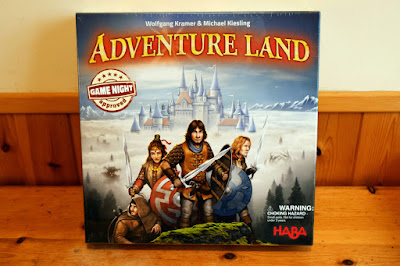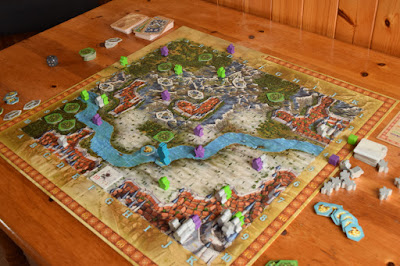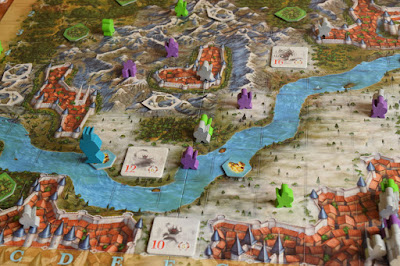Adventure Land Board Review Game5
The game takes place in a mysterious kingdom, a land that is conveniently divided into a 10×10 grid for ease of navigation, presumably because its ruler is very organised. It’s your job to score victory points and thereby defeat the other players, with the exact method of scoring points changing based on which of the three missions you undertake, but we’ll get back to that later on as all the gameplay mechanics remain the same regardless. Along the way you’ll get to battle awesome looking fog monsters, drag companions along with you and…uh, well that’s about it for theme. Thus far HABA’s line of family games haven’t placed much emphasis on marrying theme with gameplay mechanics, and so Adventure Land is a fairly abstract experience. There’s a vague relationship between what’s going on and the whole land of adventure thing, but only if you squint quite hard.We wrap up the trio of HABA game reviews (See the Spookies review here and the Karuba review here) with Adventure Land. Like HABA’s other two family games Adventure Land can be taught very quickly to both adults and children, although it’s not as intuitive as Karuba and thus even the minimum age of 8 on the box might struggle just a little to grasp a couple of the mechanics. This is an easy game to play that nevertheless has a gratifying layer of strategy that makes each match interesting. Turns rocket by as all players have to do is flip over a few cards, add a couple of things to the board and then move.
The game takes place in a mysterious kingdom, a land that is conveniently divided into a 10×10 grid for ease of navigation, presumably because its ruler is very organised. It’s your job to score victory points and thereby defeat the other players, with the exact method of scoring points changing based on which of the three missions you undertake, but we’ll get back to that later on as all the gameplay mechanics remain the same regardless. Along the way you’ll get to battle awesome looking fog monsters, drag companions along with you and…uh, well that’s about it for theme. Thus far HABA’s line of family games haven’t placed much emphasis on marrying theme with gameplay mechanics, and so Adventure Land is a fairly abstract experience. There’s a vague relationship between what’s going on and the whole land of adventure thing, but only if you squint quite hard.
To set up each player gets a set of adventurers, the exact number being determined by the amount of folk around the table, and places them around the top left corner of the board. With that done someone draws eight cards from the terrain deck, ignoring any fog monsters drawn at the time, and seeds the board with the items shown, placing the corresponding tokens on the grid coordinates shown. There’s a pattern to this; the woodlands get herbs, the mountain gets swords, the river spawns gold and the cities are home to companions. It’s these tokens that you’ll move around the board to collect.
At the beginning of your turn you flip over two new terrain cards and put down the indicated items, and then you begin moving your adventurers. In a turn you can opt to either move a single piece twice, or move two pieces once each. If you end a move on a tile containing a sword, herb or piece of gold you pick it up, and if wind up standing on a fog monster then you fight it. The catch is how adventurers are moved around the board. You can’t just shift them from place to place as you see fit. No, they can only ever be moved down or to the right, never back up or to the left, creating a gradual shift toward the bottom-left of the board. It’s an interesting mechanic because it forces you to consider your moves in advance. It’s tempting to leap down the board to grab a few things or battle a fog monsters, but of course the further down you move a piece the less useful it becomes since it can’t collect anything that spawns further up. You must therefore attempt to weigh up your need for certain tokens or companions versus. Why exactly can you only move down and right? No idea. Maybe the entire kingdom is horribly titled and every time an adventurer tries to go uphill or to the left he/she looks at the incline and declares, “bugger that.”
Read also : The Galleriest Review
Battling fog monsters is one sure-fire way of acquiring victory points across all three mission types, hence there’s a lot less of them than there any other type of token or tile. To fight and defeat these creatures you need to have a combat strength equal to or higher than them, as listed on their tiles. An adventurer is worth one combat strength by default, and each companion accompanying them adds another point. Obviously, though, you probably won’t be dragging a trail of companions around in most instances, so something more is required. For every sword token you spend, up to a maximum of three, you can roll a die and add it to your combat strength. If that still isn’t enough then once the die or dice have been tossed you’ve got another two opportunities to power up further by spending herbs to add their value to the total, or by using gold which can either add a single point of strength or re-roll a die. If you manage to defeat the monster then you claim the victory points for it, but if you fail then the adventurer is removed from the game along with any companions that were involved, too.
The final gameplay mechanic that needs to be talked about is the Water Sprite, a spirit that guards the gold within the river. Whenever a nugget of the precious metal is spawned the Water Sprite moves along the river to it, and any adventurers that it passes by are immediately removed from the game. Considering gold is worth two points across all thee game types it makes the Water Sprite a potentially dangerous trap, but if you keep an eye on where gold has already appeared you can skirt around it, or just make sure you don’t stay on the river.
So let’s run down the mission types, shall we? The first scenario is titled The Fellowship in what can only be a clear nod to the Lord of the Ring’s legendary group of companions. Here killing fog monsters and claiming pieces of gold both award victory points, but the biggest source of points comes from gathering up companions. For the first companion an adventurer collects the player scores a point, and for the second they score two, and so on and so on. Naturally it encourages players to make a dash for companions, gathering them up with just one or two adventurers for maximum points. It’s easy to fall into the trap of dashing around the board to grab faraway companions and forget about gathering gold or killing the fog monsters, which can turn the tide of a game quickly. The second scenario is The Magnificent which places a higher emphasis on battling fog monsters since their combat strength becomes their value in victory points. Players also gain points for gold, swords and herbs, but only at the end of the game, thus any that are used throughout the adventure don’t count. This makes herbs quite valuable as they can often be worth three or four points apiece. It also modifies the rules so that more than one adventurer can be in the same space, instead letting them travel in groups along with companions. The largest group becomes known as the Magnificent, at the end of the game the player who controls that group will earn points equal to 3x the amount of adventurers and companions in it, a potentially hefty sum. The final scenario is Escape to the Cities and really ramps up the scoring possibilities. Whomever kills the most fog creatures earns bonus points, with second place getting a smaller amount and third receiving just one point. The same goes for capturing gold. Finally points will be awarded for controlling the various cities on the board by having the most adventurers and companions in them.
These different mission types do an effective job of spicing up the gameplay, providing different ways of scoring so that player’s can try varying strategies. This is especially true of the third scenario which saw my own group taking different paths to success; one attempted to secure as many companions as early as possible to take over the largest city with which would be worth twelve points at the end of the game, while I chose to focus on battling fog creatures and grabbing gold and the final player opted for a mixture of tactics. We were all quit close by the end. Perhaps more importantly for a family game the three scenarios are also a good way of tailoring the difficulty since the first one basically just awards points for doing anything, so kids can trundle along and still get on the scoreboard.
The game draws to a close when you run out of both sword tokens and companions, creating a countdown to the end that’s somewhat randomized since you can never be entirely sure how quickly all the swords and companions will pop up in the terrain deck. However, since there’s 100 cards you can usually be certain that it’ll last a little while.
It’s a spatial puzzle of sorts, the random nature of the cards ensuring that each game doesn’t feel exactly the same. It’s possible to keep track of the cards in order to figure out where new things are mostly likely to pop up, although my own terrible memory is far from capable of doing that. It’s fast-paced and simple, yet there’s a reasonable layer of strategy that keeps you engrossed.
The components are mostly top-notch. The board features a fairly generic but pretty visual style while the many tokens that end up adorning it are made of a thick card stock. The wooden meeples that act as adventurers are pretty standard far and make a nice clicking sound when you scoot them around the board, because as all gamers know the sound of a click or clack on a board is immensely important to the quality of the game. There’s only problem with the otherwise rock-solid presentation; the terrain cards. Made of a flimsy, thin card they don’t feel very durable or nice to handle. Considering you only ever briefly interact with them, though, it’s not a huge problem.
While Adventure Land didn’t manage to capture my imagination in the same way that the prior HABA game I reviewed did, it was still a very solid entry into the family market for the company. It’s easy to learn and can be played quickly which is exactly what you want if you’re attempting to get a couple of kids to sit down and play, too. Aiding the family theme is that while it is a competitive game there’s an air of friendliness since you can’t really block other players or otherwise mess with them. Of course that does mean there’s not much in terms of interactivity between players.
Each turn presents a spatial awareness puzzle of sorts, with the new items appearing on the board changing what you need to do. You’re constantly deciding what your objective should be, and more importantly how far to move your adventurers to gain an advantage. This creates a nice risk vs reward mechanic since scooting down the board too quickly can result in an early and decisive advantage or a lot of lost points later on. In other words, optimisation of your move is key, which is a theme we saw in Karuba as well.
It may not be the land of adventure that the name promises but Adventure Land is nevertheless a very entertaining family game. HABA, it seems, have taken their entry into the family very seriously with their trio of games thus far, and I can’t wait to see what else they’ve in store for the future.
Designed by: Wolfgang Kramer & Michael Kiesling
Published by: HABA
Players: 2-4
Read also : The Village Crone



